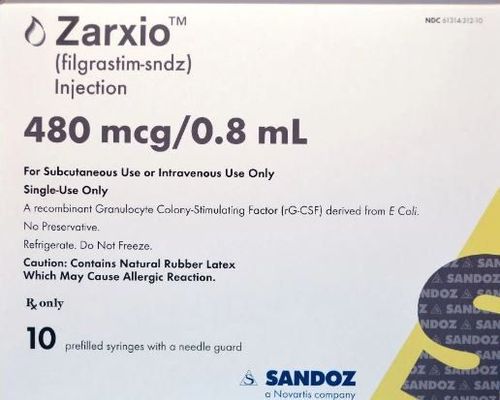This is an automatically translated article.
Laryngeal cancer is a common disease in people over 60 years of age and is more common in men than women. The stages of laryngeal cancer will help doctors plan the most appropriate treatment and predict the patient's prognosis and response to treatment.
1. What is laryngeal cancer?
The larynx is a part of the throat located at the entrance to the trachea. The larynx consists of three main parts: the glottis, the glottis, and the hypoglottis. The larynx plays a role in the formation of voice or sounds from the vocal cords, preventing food or drink from entering the respiratory tract by closing the epiglottis and allowing inhaled air to reach the lungs.
Laryngeal cancer is the appearance of malignant tumors inside the larynx. Laryngeal cancer usually begins in the glottis. The most common disease is squamous cell cancer. There are also several other types including squamous cell carcinoma, adenocarcinoma, rhabdoid and basal squamous cell carcinoma,...
2. What are the stages of laryngeal cancer?
Laryngeal cancer stages indicate the extent of cancer and its location in the body. For laryngeal cancer, tests such as laryngoscopy, endoscopy, fine needle aspiration, CT scan, MRI, and/or PET may be performed to help stage laryngeal cancer. Cancer stages help doctors plan the best treatment for a patient. Staging laryngeal cancer is based on:
Location, size of the tumor. Has the tumor spread to the lymph nodes or to other organs? The staging system for laryngeal cancer is complex. Here is the system used in staging laryngeal cancer:
Stage 0: The tumor is only on the surface of cells in the larynx and has not spread to any lymph nodes or organs other part of the body. Stage I: Epiglottitis: Tumor affects only the upper glottis, vocal cords are not affected, Tumor has not spread to lymph nodes or other parts of the body. Cancer of the glottis: The tumor is located on the vocal cords and does not change the vocal cords' ability to move. The tumor has not spread to lymph nodes or other parts of the body. Subglottal cancer: Tumor affects only the lower glottis, has not spread to lymph nodes and other parts of the body Stage II: Epiglottitis: Tumor is in more than one part of the glottis supraglottic or glottis region; or located externally near the base of the tongue or the wall of the sinuses and not attached to the larynx. The tumor has not spread to the lymph nodes and other parts of the body. Cancer in the glottis: The tumor is in the glottis and has grown above or below the glottis. The mobility of the vocal cords is also affected. Subglottic cancer: The tumor is located in the subglottis and has also grown to the vocal cords. Vocal cord mobility may or may not be affected. Stage III The tumor is in the larynx, preventing the vocal cords from moving, or the tumor has grown to other sites in the larynx or thyroid cartilage. The tumor may also have spread to one or more lymph nodes on the same side of the neck as the tumor and is no larger than 3cm. Stage IV The cancer has grown to other parts of the larynx, such as the windpipe, tongue, thyroid, or esophagus. In some cases, the tumor can also affect the carotid artery or other organs in the chest. Cancer has also spread to the lymph nodes. The most advanced type of laryngeal cancer, called stage IVC, means the cancer has spread to other organs.
3. How is laryngeal cancer treated?
Treatment for laryngeal cancer depends on the location, size and extent of the tumor. Treatment may include one or all of the therapies including surgery, chemotherapy, and radiation.
3.1. Surgery The goal of surgery is to remove all or as much of the cancer cells as possible while not damaging other tissues or organs near the tumor. There are several surgical options to treat laryngeal cancer. Possible surgical treatments for laryngeal cancer include:
Vocal cord stripping: The top layer of tissue of the vocal cords is removed with a long surgical instrument. This procedure is used to biopsies or treat stage 0 cancer. After recovery, the voice remains normal. Vocal cordectomy: Part or all of the patient's vocal cords are removed. The extent of the effect on the ability to speak depends on the amount of vocal cords removed. If only part of the vocal cords are removed, the patient may develop hoarseness. If both wires are removed, the patient will not be able to speak normally. Laryngectomy: There are several different types: Partial laryngectomy: This procedure is used while the tumor is small. Laryngectomy is of two types: Epiglottitis: The part of the larynx above the vocal cords, called the epiglottis, is removed. Patients will be able to speak normally after partial laryngectomy: Used in smaller tumors of the vocal cords, involving removal of one side of the larynx and one vocal cord. Because some of the vocal cords are still present, the patient may still talk afterward, but the voice may change. Total laryngectomy: Used in advanced laryngeal cancers, the entire larynx is removed. The “false” trachea is opened through the skin at the front of the neck creating an air hole for the patient to breathe. This is called a tracheostomy. The patient will not be able to speak normally. After recovering from surgery, the patient should be able to swallow normally. Laser surgery: In laser surgery, an endoscope is placed in the mouth and down the throat to find a tumor and then vaporize or remove the tumor using a laser on the end of the endoscope. . When this technique is used to remove part of the vocal cords, it can result in a hoarse voice. Lymph node dissection: If the doctor thinks cancer has spread to the lymph nodes, they may choose to have surgery or remove the lymph nodes. There are several types of surgery, ranging from removing one or a few lymph nodes to removing lymph nodes, nerves, and muscles. The surgeon will determine the extent of dissection needed based on the size and location of the original tumor. If cancer has grown into the throat, the patient may have surgery to cut part or all of the throat, which is to remove the throat. If the cancer has affected the thyroid gland, the patient may need surgical removal of the thyroid gland. After any surgery the patient may need further treatment to help with recovery. Postoperative supportive therapies include:
Speech and swallowing therapy: If speech or swallowing ability is affected by surgery, the patient will be referred to a speech therapist. They can teach patients techniques and provide tools to improve speech and swallowing. Nutritional support: If it is not possible to swallow normally to maintain proper nutrition after surgery, the patient may be placed on a nasogastric tube. This is a tube that is placed directly into the stomach to deliver liquid nutrients. This may be temporary until the patient's ability to swallow has improved enough to maintain proper nutrition. Reconstructive surgery: Patients may also need reconstructive surgery depending on the amount of normal tissue that was removed. It may be necessary to remove skin from a body part to replace the skin and tissues removed during surgery. 3.2. Radiation therapy Radiation therapy uses high-energy X-rays to kill cancer cells. Radiation may be used as a sole treatment or in combination with surgery and/or chemotherapy. Early-stage laryngeal cancer can be treated with radiation alone. This may preserve better voice quality for some patients. When radiation is used along with surgery, it is called adjuvant therapy. Radiation may be used after surgery to kill any remaining cancer cells and reduce the risk of recurrence. Radiation may also be used for patients who cannot have surgery or whose cancer is advanced, with the aim of controlling symptoms, such as pain and bleeding. It can lead to side effects such as skin irritation and can affect nearby glands and tissues.
3.3. Chemotherapy Chemotherapy is the use of anti-cancer drugs given intravenously or orally to kill cancer cells. Chemotherapy is used to treat laryngeal cancer if it has spread (metastasized) or if the cancer was not completely removed during surgery. Chemotherapy drugs commonly used to treat laryngeal cancer include cisplatin, carboplatin, fluorouracil, docetaxel, paclitaxel, methotrexate e, capecitabine, and epirubicin. Chemotherapy and radiation therapy may be used together (called chemoradiotherapy). Drugs used in chemotherapy include carboplatin, cisplatin, docetaxel, and/or cetuximab.
3.4. Cetuximab immunotherapy, a targeted drug, can be used in combination with chemotherapy or radiation to treat laryngeal cancer. Immunotherapy is the use of a person's own immune system to destroy cancer cells. Pembrolizumab and nivolumab are both immunomodulatory drugs that target and block PD-1. PD-1 is a protein, and when blocked, the body initiates an immune response against cancer cells, shrinking or slowing tumor growth. These drugs may be used for the treatment of recurrent cancer. In some cases, pembrolizumab is the first type of treatment used.
In summary, the treatment for laryngeal cancer will depend on many factors such as the stage of the disease, the patient's health and needs. In general, patients with laryngeal cancer often have a better prognosis than some other cancers because they are often diagnosed and treated early. To detect laryngeal cancer early in the early stages, patients should have regular cancer screening, especially when the body has abnormal signs.
Early cancer screening is considered the perfect measure in timely detection and treatment of cancers. Reduce the cost of treatment and especially reduce the mortality rate in patients. Vinmec International General Hospital always deploys and introduces to customers HIGH-TECH CANCER CHECKLIST AND SCREENING PACKAGE for gene testing, imaging, and biomarkers for early tumor detection. Vinmec International General Hospital has many early cancer screening packages. Only one gene test can assess the risk of 16 common cancers in both men and women (lung cancer, colon cancer) rectal cancer , breast cancer , pancreatic cancer , cervical cancer , stomach cancer , prostate cancer ,....)
Early detection of early signs of cancer through diagnosis imaging, endoscopy and ultrasound. The operation is simple, careful and accurate. A team of well-trained specialists, especially in oncology, are capable of handling cancer cases. With facilities, advanced and modern medical equipment and a team of doctors with deep expertise and experience. At Vinmec, the examination process becomes quick with accurate results, saving costs and time for patients.
Please dial HOTLINE for more information or register for an appointment HERE. Download MyVinmec app to make appointments faster and to manage your bookings easily.













